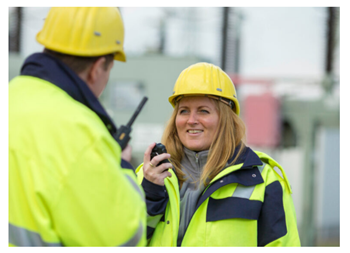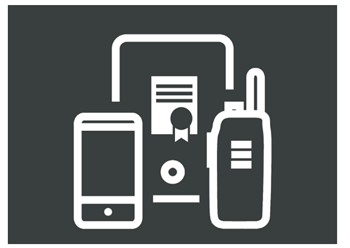A guide to selecting the right communication system
Are you using multiple devices to communicate and share data? Is it time to consider how to reduce costs and enhance efficiency? Regardless of the industry or user, having the right tools to hand and the ability to respond and react quickly to any situation is imperative. It is estimated that companies lose 20 to 30% of their revenue due to inefficiency every year, and many of these costs go unnoticed according to the global market research carried out by the IDC. Coupled with the statistics produced by OnePoll; 26% of every employee’s day is wasted. 38% of respondents said their employers used manual administrative processes. 48% believed better technology would have made them more productive. Based on the data, it’s clear that employees are frustrated in workplaces where paper-based and manual processes are still commonplace. Nearly half (44%) of UK respondents classed their company’s technology as out-dated. Costs soon add up The benefits of improved technology to morale are less quantifiable. Investing in solutions that will benefit the bottom line, rather than micromanaging your employees makes a lot of sense. So how can your two way radio or broadband push to talk (BBPTT) communications system be made more efficient so that tasks are more productive and processes are safer, whilst giving your employees real-time information at their fingertips? Transforming your communication systems The right communication system can offer many benefits by enabling a seamless and secure flow of information across your organisation to connect your people and their varying locations, and providing actionable insights by getting the right information, into the right hands, at the right time. But where do you start? This blog post offers an insight into how to identify your challenges, and the process to follow to help you to achieve your goals, and do more with less. Step One – identifying your challenges It is crucial for organisations to be able to keep up with technology, as it is constantly evolving and changing. This is in addition to facing daily challenges that can affect your ability to operate effectively. Identifying and addressing these challenges are the first steps towards achieving success in the workplace. Here are three of the top challenges identified by our clients that you may recognise, or have experienced: Challenge #1 Safety Hectic workplace environment, with no time to assess operations or spot warning signs. Lone workers and support teams are often not tracked leading to safety implications. Difficulties in sharing information efficiently during an emergency situation to ensure a rapid response. Challenge #2 Mixed Messages Workers that lack correct training lead to inefficiencies, errors and downtime. Cross-communication between employees results in multiple employees doing the same job or no one doing it at all. Employees who carry multiple devices frequently duplicate work or leave tasks unassigned. Checks are often reliant on manual processes, causing process failures to become a crisis and stopping the workflow. Challenge #3 Productivity Technologies utilised do not support connected communication and information cannot be shared across multiple devices – voice calls, text messages, files, video and images – teams have to carry multiple devices. Where multiple sites control different processes. Error margins are higher with paper job scheduling and reporting. Step two – the process of selecting the right communication system for your organisation 1. Assess your organisation’s communication needs: The first step in selecting the right radio or BBPTT communication system and software for your organisation is to define your requirements. This includes determining the type of communication (e.g. voice, data, video, text, etc), the number of users, the desired features and capabilities, the expected usage, and any other specific requirements. Take the time to clearly define your needs. 2. Consider your budget: Once you have determined your communication needs, you need to consider your budget, will it be funded from CapEx and OpEx. How much can your organisation afford to spend on procuring, or upgrading your communication system? What are the ongoing costs to maintain the system? 3. Research the available options: The next step is to research the available communication systems and software options. This involves researching the different types of communication systems and software, reading user reviews, identifying the best suppliers, comparing the features and capabilities of the different products, and determining which products best meet the requirements identified in step 1. Identify if the system can allow you to eliminate the need to carry multiple devices, for example a BBPTT or two way radio system can support workforce management, job ticketing, telephone calls, video, lone worker tracking and much more. Additionally, ensure that the suppliers you have identified offer the level of after sales service you require, for example, warranties, onsite or remote support support, PMI visits, or managed services. 4. Test the system and software: Once the best options have been identified, it is important to test the BBPTT or two way radio system and software to ensure it meets the requirements and is easy to use. This can be done by setting up a trial version of the system and software, running tests, and asking users to provide feedback. 5. Make a decision: Once the testing is complete, it is time to make a decision. All of the feedback from the testing should be taken into account when making the decision. As mentioned in step 2 it is also important to understand the long-term costs, including maintenance, support and upgrades, as well as the potential for future expansion. At this time, also consider how you will implement the system and software. This includes setting up the system ensuring the system is properly tested, configured and secure. Furthermore, if other departments need input at the deployment stage ensure they are fully briefed. And finally, allow for time to ensure users will be trained so they understand the features and capabilities of the system, as well as safety protocols. Summing up Removing the complexity and barriers from your communications technology choices can maximise the benefits. By having the right communication devices in place users can work more efficiently, collaborate effectively, and respond quickly to any situation they may encounter. Additionally, having the right communication tools can help to streamline processes, and improve customer service. Are you considering how you can select the right communication system for your organisation? Unsure of which route to go down – two way radio or BBPTT? Our sector is advancing rapidly and their capabilities can make a real difference to your employees and your organisation. To start a conversation you can reach us on:Visit the Radiocoms Systems Limited website for more information on A guide to selecting the right communication system





